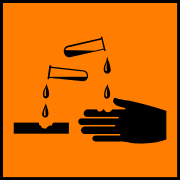|
Arrhenius acids are substances that provide free hydrogen ions in aqueous solution. |
|
Acids
Arrhenius' definition of an acid is the one that most people are familiar with, a substance that produces hydrogen ions in water:
|
hydrochloric acid
|
+ |
water
|

|
hydrogen ions | + | chloride ions |
|
HCl
|
(aq)
|
H+(aq)
|
Cl-(aq)
|
| HCl(aq) |
Acids are simply a group of compounds with similar chemical behaviour - i.e. they react in similar ways with other compounds. This is because all acids contain these free H+ ions (hydrogen ions) in solution. It is these H+ ions that are actually reacting.
The hydrogen ion is effectively a single proton, whose charge density (charge/volume ratio) is very large. It is an extremely reactive species and, in all probability, bonds with the water molecules themselves, making a hydroxonium (also called hydronium or oxonium) ion.
|
Formation of the hydronium ion (click the diagram)
Although the hydrogen ions are bonded to the water molecules, this does not really make much difference, as we can simply deal with acids as solutions containing free hydrogen ions. |
|
Characteristic acid behaviour
|
|
1 Acids turn indicators characteristic colours (the actual colour depends on the indicator). 2 Acids react with bases to form salt and water (neutralisation). The base may be a metal oxide or a metal hydroxide. 3 Acids react with carbonates forming a salt, carbon dioxide and water (neutralisation) 4 Acids react with active metals to form salt and hydrogen (this is not actually a neutralisation reaction, although the acid does get used up) |
These properties are only expressed in aqueous solution (i.e. a solution in water). This is because acids only release their hydrogen ions when they interact with water molecules.
Consequently, hydrochloric acid provides a solution that contains hydrogen ions and chloride ions - It is only the hydrogen ions that react with bases, the chloride ions remain in the solution as spectator ions.
Common strong acids:
- Sulfuric acid - the solution contains hydrogen ions and sulfate ions.
- Hydrochloric acid- the solution contains hydrogen ions and chloride ions.
- Nitric acid - the solution contains hydrogen ions and nitrate ions.
- Phosphoric acid - the solution contains hydrogen ions and phosphate ions.
In all cases, the acid provides a source of hydrogen ions.
Properties of acids
All acids are solutions that contain free hydrogen ions and for that reason they all have similar properties. The properties of acids can be summarised as follows:
- They dissolve in water to give a solution with pH less than 7
- They react with bases to give a salt and water
- They give distinctive colours when in contact with indicators
Properties of bases
The term "base" refers to a group of compounds whose properties are reflections of those of acids. They are usually thought of as the 'chemical opposite' of acids.
Bases either produce hydroxide ions directly by dissolving, or they assist the water molecules in breaking apart by removing H+ ions from the water. (The situation is a little more complicated than explained, as the water is actually in equilibrium with its own ions). Bases have characteristic properties.
- They dissolve in water to give a solution with pH more than 7.
- They react with acids to give a salt and water
- They give distinctive colours when in contact with indicators
There are several types of compounds which all come under the general heading of 'bases'.
| Base | example | formula | solubility |
|---|---|---|---|
|
Metal hydroxides
|
Sodium hydroxide
|
NaOH
|
very soluble
|
|
Metal oxides
|
Calcium oxide
|
CaO
|
reacts with water
|
|
Metal carbonates
|
Magnesium carbonate
|
MgCO3
|
insoluble
|
|
Metal hydrogen carbonates
|
Sodium hydrogen carbonate
|
NaHCO3
|
soluble
|
|
Metal sulfites (sulfate(IV))
|
Sodium sulfite
|
Na2SO3
|
soluble
|
|
Ammonia solution
|
Ammonia (aq)
|
NH3(aq)
|
very soluble
|
|
Amines
|
Methylamine
|
CH3NH2
|
slightly soluble
|
Note: An alkali is just a soluble base.


